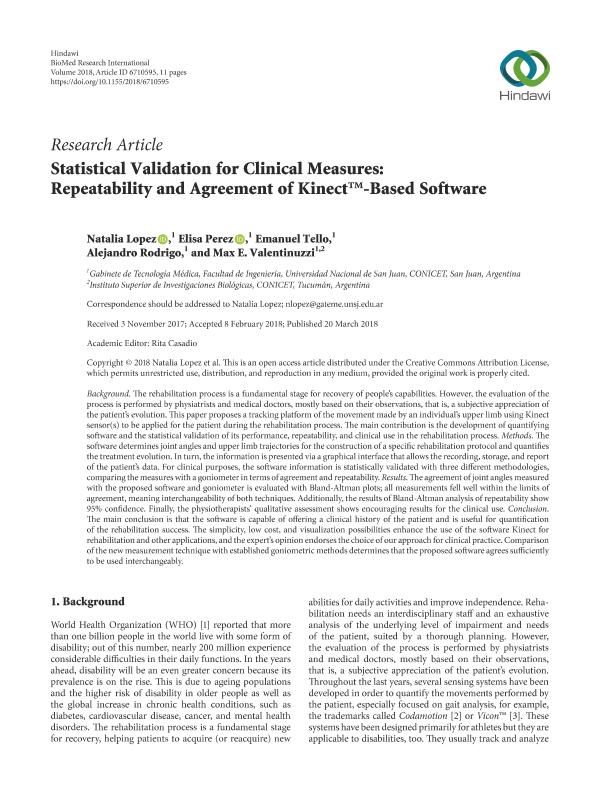Mostrar el registro sencillo del ítem
dc.contributor.author
López Celani, Natalia Martina

dc.contributor.author
Pérez Berenguer, María Elisa

dc.contributor.author
Tello, Emanuel Bienvenido

dc.contributor.author
Rodrigo, Alejandro

dc.contributor.author
Valentinuzzi, Maximo

dc.date.available
2021-11-19T18:43:35Z
dc.date.issued
2018-03-20
dc.identifier.citation
López Celani, Natalia Martina; Pérez Berenguer, María Elisa; Tello, Emanuel Bienvenido; Rodrigo, Alejandro; Valentinuzzi, Maximo; Statistical validation for clinical measures: Repeatability and agreement of Kinect based software; Hindawi Limited; BioMed Research International; 2018; 6710595; 20-3-2018; 1-11
dc.identifier.issn
2314-6133
dc.identifier.uri
http://hdl.handle.net/11336/147203
dc.description.abstract
Background. The rehabilitation process is a fundamental stage for recovery of people's capabilities. However, the evaluation of the process is performed by physiatrists and medical doctors, mostly based on their observations, that is, a subjective appreciation of the patient's evolution. This paper proposes a tracking platform of the movement made by an individual's upper limb using Kinect sensor(s) to be applied for the patient during the rehabilitation process. The main contribution is the development of quantifying software and the statistical validation of its performance, repeatability, and clinical use in the rehabilitation process. Methods. The software determines joint angles and upper limb trajectories for the construction of a specific rehabilitation protocol and quantifies the treatment evolution. In turn, the information is presented via a graphical interface that allows the recording, storage, and report of the patient's data. For clinical purposes, the software information is statistically validated with three different methodologies, comparing the measures with a goniometer in terms of agreement and repeatability. Results. The agreement of joint angles measured with the proposed software and goniometer is evaluated with Bland-Altman plots; all measurements fell well within the limits of agreement, meaning interchangeability of both techniques. Additionally, the results of Bland-Altman analysis of repeatability show 95% confidence. Finally, the physiotherapists' qualitative assessment shows encouraging results for the clinical use. Conclusion. The main conclusion is that the software is capable of offering a clinical history of the patient and is useful for quantification of the rehabilitation success. The simplicity, low cost, and visualization possibilities enhance the use of the software Kinect for rehabilitation and other applications, and the expert's opinion endorses the choice of our approach for clinical practice. Comparison of the new measurement technique with established goniometric methods determines that the proposed software agrees sufficiently to be used interchangeably.
dc.format
application/pdf
dc.language.iso
eng
dc.publisher
Hindawi Limited
dc.rights
info:eu-repo/semantics/openAccess
dc.rights.uri
https://creativecommons.org/licenses/by/2.5/ar/
dc.subject
REHABILITATION ENGINEERING
dc.subject
KINECT' SENSOR
dc.subject
MOVEMENT EVALUATION SOFTWARE
dc.subject
UPPER LIMB MEASURES
dc.subject
STATISTICAL VALIDATION
dc.subject.classification
Otras Ingeniería Médica

dc.subject.classification
Ingeniería Médica

dc.subject.classification
INGENIERÍAS Y TECNOLOGÍAS

dc.title
Statistical validation for clinical measures: Repeatability and agreement of Kinect based software
dc.type
info:eu-repo/semantics/article
dc.type
info:ar-repo/semantics/artículo
dc.type
info:eu-repo/semantics/publishedVersion
dc.date.updated
2021-07-05T14:34:35Z
dc.identifier.eissn
2314-6141
dc.journal.volume
2018
dc.journal.number
6710595
dc.journal.pagination
1-11
dc.journal.pais
Egipto

dc.journal.ciudad
El Cairo
dc.description.fil
Fil: López Celani, Natalia Martina. Universidad Nacional de San Juan. Facultad de Ingeniería. Departamento de Electrónica y Automática. Gabinete de Tecnología Médica; Argentina. Consejo Nacional de Investigaciones Científicas y Técnicas. Centro Científico Tecnológico Conicet - San Juan; Argentina
dc.description.fil
Fil: Pérez Berenguer, María Elisa. Universidad Nacional de San Juan. Facultad de Ingeniería. Departamento de Electrónica y Automática. Gabinete de Tecnología Médica; Argentina. Consejo Nacional de Investigaciones Científicas y Técnicas. Centro Científico Tecnológico Conicet - San Juan; Argentina
dc.description.fil
Fil: Tello, Emanuel Bienvenido. Universidad Nacional de San Juan. Facultad de Ingeniería. Departamento de Electrónica y Automática. Gabinete de Tecnología Médica; Argentina. Consejo Nacional de Investigaciones Científicas y Técnicas. Centro Científico Tecnológico Conicet - San Juan; Argentina
dc.description.fil
Fil: Rodrigo, Alejandro. Universidad Nacional de San Juan. Facultad de Ingeniería. Departamento de Electrónica y Automática. Gabinete de Tecnología Médica; Argentina
dc.description.fil
Fil: Valentinuzzi, Maximo. Consejo Nacional de Investigaciones Científicas y Técnicas. Centro Científico Tecnológico Conicet Noa Sur. Instituto Superior de Investigaciones Biológicas. Grupo de Investigación y Desarrollo del Noroeste Argentino | Universidad Nacional de Tucumán. Instituto Superior de Investigaciones Biológicas. Grupo de Investigación y Desarrollo del Noroeste Argentino; Argentina
dc.journal.title
BioMed Research International
dc.relation.alternativeid
info:eu-repo/semantics/altIdentifier/url/https://www.hindawi.com/journals/bmri/2018/6710595/
dc.relation.alternativeid
info:eu-repo/semantics/altIdentifier/doi/https://doi.org/10.1155/2018/6710595
Archivos asociados
